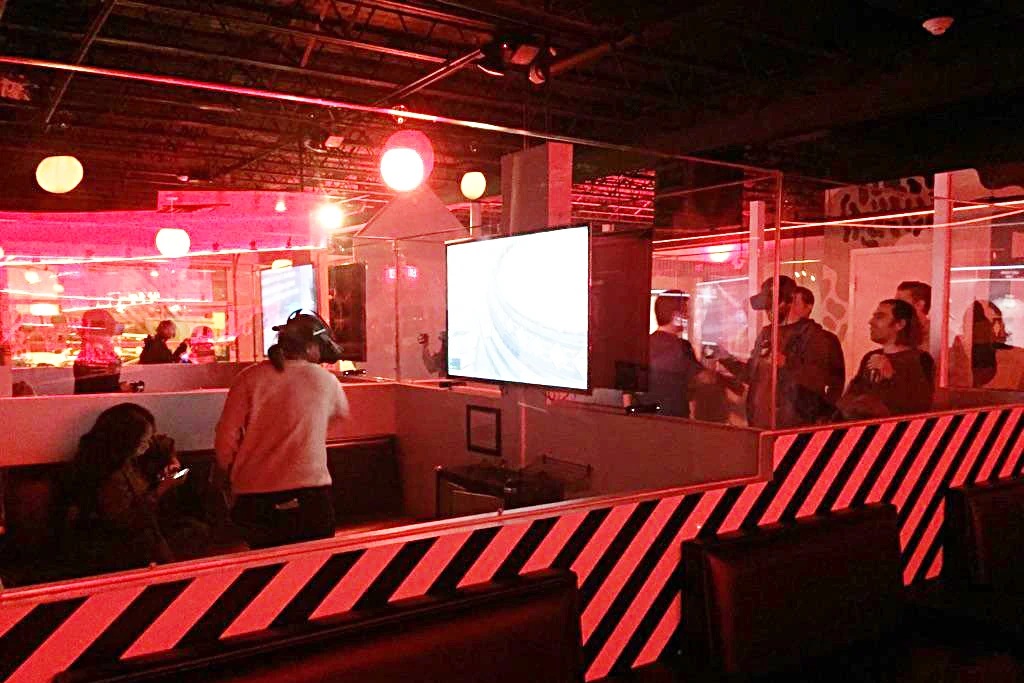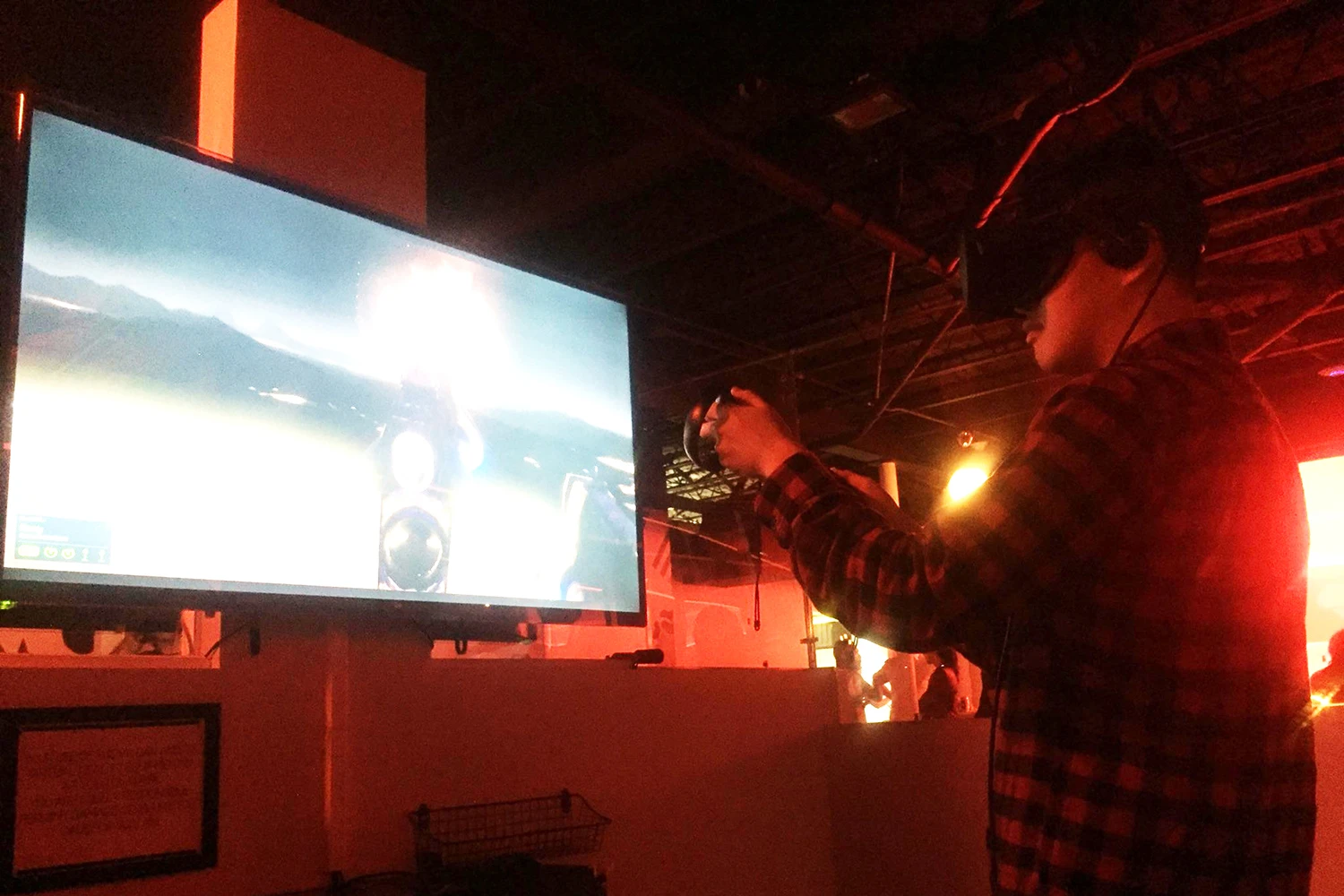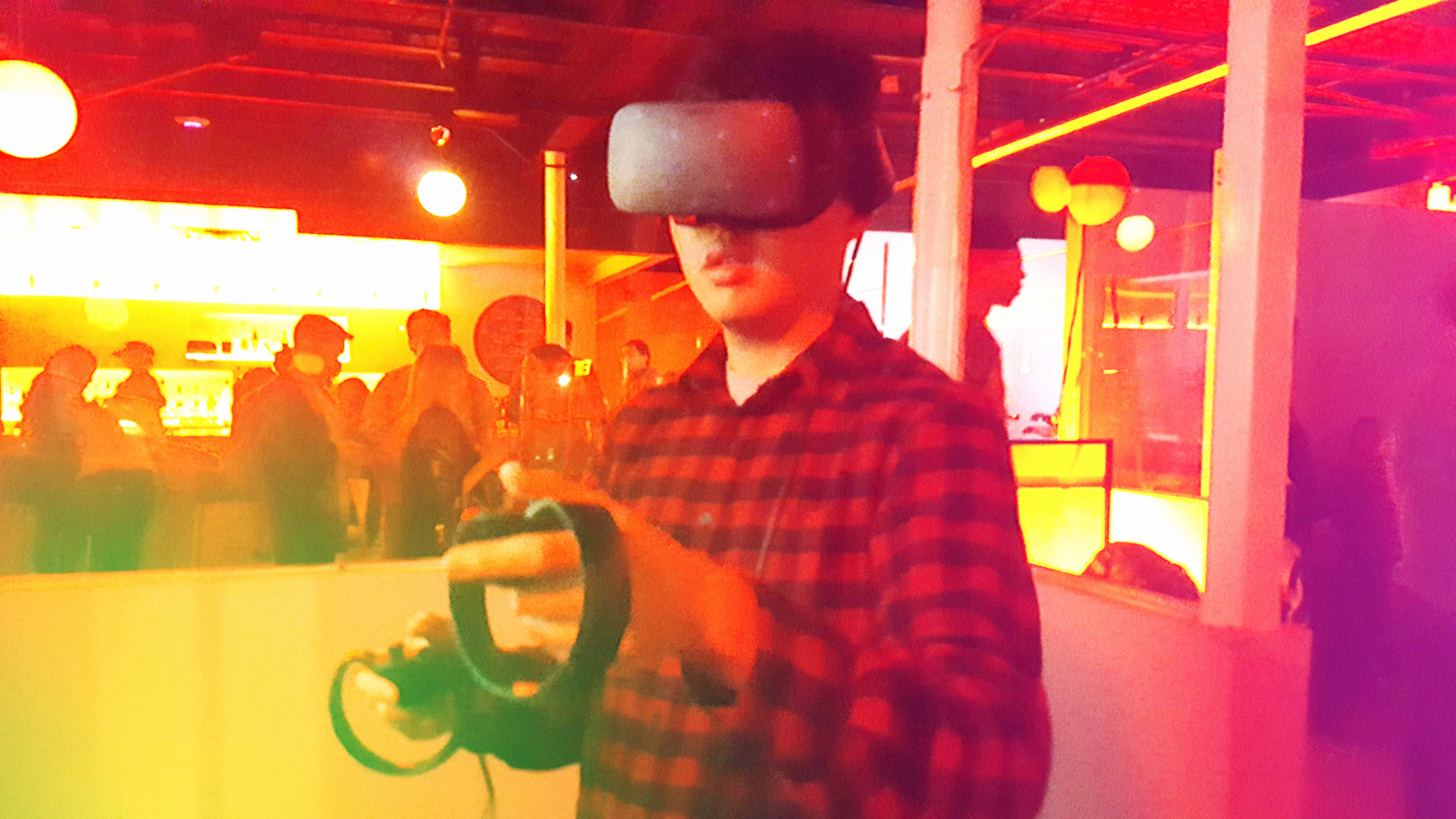Lesson No. 1: Watch out. If you don’t, someone might swing at your head while trying to fight off gladiators.
You have a lot to learn at Revery: VR Bar, a virtual reality bar in Atlanta. That bar goer-turned-gladiator, jumping around and whooping, is one of many people wearing a VR headset. Others crouch or spin or throw as friends and bystanders, holding beers, look on and laugh, and sometimes duck for cover. But those headset wearers can’t see any of that. They concentrate on the reality in front of their eyes, whether that’s shooting baskets or zapping zombies in a desert.
Revery, which opened in late December 2017, is part of an uptick of spaces and arcades around the world dedicated to socializing around VR. “I’m just really fascinated that people are coming up with these very creative ideas to popularize–I guess even democratize–the way that virtual reality is being used,” says Sun Joo (Grace) Ahn, director of the Games and Virtual Environments Lab at the University of Georgia.
But is virtual reality a viable way to spend a fun night out with friends?
It’s Saturday night, and the white space at Revery is cloaked in red light. House and techno music pulses so loudly that we can feel it reverberate through the seats and into our chests. It feels futuristic, and a red neon Biggie Smalls quote greets people as they enter: “It was all a dream.”
A bar is in the back, and the rest of the space is divided into windowed cubicles with a mix of HTC VIVE and Oculus VR equipment. Each cubicle has a large screen, a bench for onlookers to sit, and a VR headset, with one person playing at a time.
On a typical Friday or Saturday, there’s a wait for the VR rooms. Vincent Wynn II, co-owner of Revery, says 250 to 300 people come to the bar on peak weekend nights. On this Saturday, the relatively young crowd has more men than women, though not many more. And almost everyone is watching someone play a VR game.
Like us, most of the bar goers seem new to VR. Everyone is figuring out how to use it. We’re pioneers seeing how this works—and maybe gripping a beer for good measure.
The employees know this. In addition to bestowing drinks, they also readily offer technical support when questions arise about how to use the VR, or if the game freezes, which it does about every 20 minutes. The technology hasn’t reached perfection. After signing in with a front desk and not signing any waivers, our group starts with a beginner’s game shooting robots in space. Like most other patrons, we each take turns playing for a few minutes.

Wynn—who came up with the idea of the bar while brainstorming concepts with his business partner, Michael Randolph—points out the unusual interpersonal dynamics that arise out of communal virtual reality. “The social aspect of people letting loose and kind of forgetting that other people are watching them, I kind of think is one of the most fun parts about having VR in a group area,” he says.
He has a point. It is weirdly amusing watching people pantomiming in their own little world while watching that world on the screen, and judging by all the grinning onlookers, the feeling is universal. But for all the laughing going on, there isn’t much interaction between people. Every cube has a crowd of relatively quiet onlookers observing a single player and the screen.
After witnessing the spectacle of people playing VR, it’s time to put on the headset yourself. The goggle-like gear slips over your head, and suddenly, instead of seeing friends, you look up and see a starry expanse of space. It feels neat but also isolating.
“It does kind of take away the fun of being in a social atmosphere if you’re not sharing the same experience together,” Ahn says.
As soon as a person dons a headset to play, he almost forgets other people are there, as Wynn attests. The player can’t see anyone, and the music muffles most conversation. In short, VR feels like a solitary activity in the middle of a circle of people.
That circle of people also proves a physical obstacle. Since the cubicle is small and headset wearers can’t see, they end up trying to punch friends sitting on the nearby bench or leaping out of the cubicle into a gaggle of people. Perhaps that lack of coordination explains part of the fun of watching: You never quite know when virtual reality could become painfully real.
“Unless you are able to secure a generally safe space for people to move around without any physical objects or physical obstacles, then you might be putting these people in danger of physical harm,” Ahn says. (On Vive and Rift systems, there is an option to enable “digital walls” that help the user stay within a circumscribed space, but we didn’t see any.)
Then add the alcohol. Ahn worries that drinking and VR could make for an unappealing mix, since VR is known to cause nausea in some people. The prospect also worried Wynn. To try to avoid nausea, Revery offers mostly beginner and intermediate games without a lot of movement. (No one has gotten sick at Revery because of the VR, Wynn assures me.) On that Saturday, most of the patrons don’t seem drunk enough to have much trouble. Our group doesn’t feel any dizziness, perhaps because we take breaks as we take turns passing the headset.

Wynn says most customers aren’t serious gamers, but are people who don’t usually enjoy games. “Next thing you know, they’re smiling and jumping around and having a really great time,” he says. (Until they accidentally elbow a friend.)
Wynn says people who enjoy VR don’t necessarily use it daily, so they don’t want to pay the startup costs of a similar sophisticated system. Prices vary depending on the brand and continue to change because VR is a new technology, but a setup can cost more than $1,000 .
A bar is a solution. Plus, VR provides a different kind of hangout experience.
“It’s not the same bowling. It’s not darts or pool, which you’ve done for decades and decades,” he says. “It’s a new activity, and I think people are excited to go because as an adult, you realize there’s not many other social places to meet with your friends except bars, and everyone’s looking for a new activity to do at a bar.”
Ahn, who studies virtual experiences’ effects on how people think, feel and behave, says she’s heartened by the presence of VR places such as Revery. “Now, people are thinking that it’s commonplace enough to introduce them into bars, which I don’t know if the act of mixing together alcohol and virtual reality is necessarily wise, but it’s an interesting change in the way that people are perceiving and accepting this new technology. So in that sense, I’m encouraged that virtual reality has potential to become more ubiquitous in the future.”
At the same time, Ahn says VR hasn’t progressed to the point of being a social activity. “It sounds a little odd to be drinking together, and then you all take turns wearing a headset,” she says.
But that’s exactly what everyone at Revery does. After blasting robots, we move onto shooting baskets and a semi-horrifying game stabbing faceless apparitions. We laugh as we trip over ourselves and duck when friends try to jab us. Once our purchased hour of VR time ends, our group heads to a more traditional bar to talk over beer and a trivia card game. Somehow, for the first time that night, it feels like we are truly hanging out.
Adina Solomon is a freelance journalist based in Atlanta. Her work has appeared in the Washington Post, U.S. News & World Report, the Atlantic’s CityLab, and other outlets both in Atlanta and nationally.
Recognize your brand’s excellence by applying to this year’s Brands That Matter Awards before the early-rate deadline, May 3.
